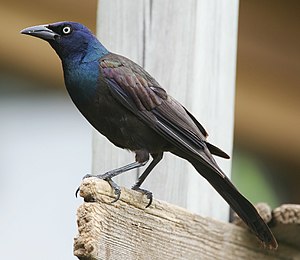Purple Grackle
| Purple Grackle | ||||||||||||
|---|---|---|---|---|---|---|---|---|---|---|---|---|

Crimson Grackle ( Quiscalus quiscula ) |
||||||||||||
| Systematics | ||||||||||||
|
||||||||||||
| Scientific name | ||||||||||||
| Quiscalus quiscula | ||||||||||||
| ( Linnaeus , 1758) | ||||||||||||
| Subspecies | ||||||||||||
|
The crimson gray grackle ( Quiscalus quiscula ) is a bird of the starch family (Icteridae).
Occurrence
Crimson Grackeln are common from southern Canada to east of the Rocky Mountains and inhabit open forests, fields and orchards, as well as urban parks and gardens. They are very sociable birds and also gather in large noisy groups at their roosts.
features
The birds reach a height of 27 to 35 centimeters. Adult purple Grackeln have a long, powerful black bill, long tail, long powerful legs and claws, and pale yellow eyes. The eyes of the young birds are brown. The plumage is black with an iridescent blue to purple sheen, but varies depending on the subspecies. The females are smaller than the males, and their plumage is not as shiny as that of the males. The singing of the adult birds, reminiscent of a rusty gate, is very characteristic.
nutrition
The nutritional spectrum is very diverse. The birds feed on nuts and berries, insects , worms and mice, among other things . Even frogs and crayfish, which they catch in ponds and streams will not be spurned. In the coastal area they wade through the water and catch fish . Occasionally, they will also eat chicks and eggs from smaller birds. During the winter, they often invade grain fields, particularly corn fields, in large groups and have become a nuisance in certain regions of North America. Also known in the city's parks and gardens as cheeky thieves who steal food from other birds.
Reproduction
Purple Grackeln are colony breeders. The large nests are made of twigs, stalks, and grass and are often built on a tree, shrub, or flat building near a body of water. The female incubates five to six eggs over a period of 12 to 14 days. Both parent animals take part in the rearing of the young birds.
Subspecies
- Quiscalus quiscula quiscula
- Quiscalus quiscula stonei
- Quiscalus quiscula versicolor
Web links
- Videos, photos and sound recordings of Quiscalus quiscula in the Internet Bird Collection
- Quiscalus quiscula in the endangered Red List species the IUCN 2008. Posted by: BirdLife International, 2008. Accessed January 31 of 2009.
- Feathers of the purple racket
